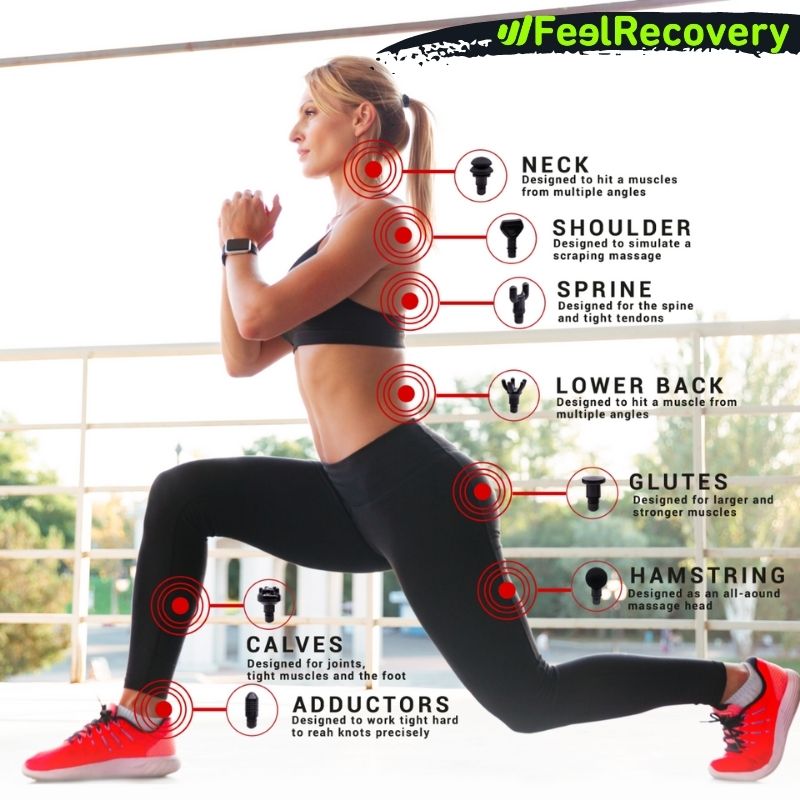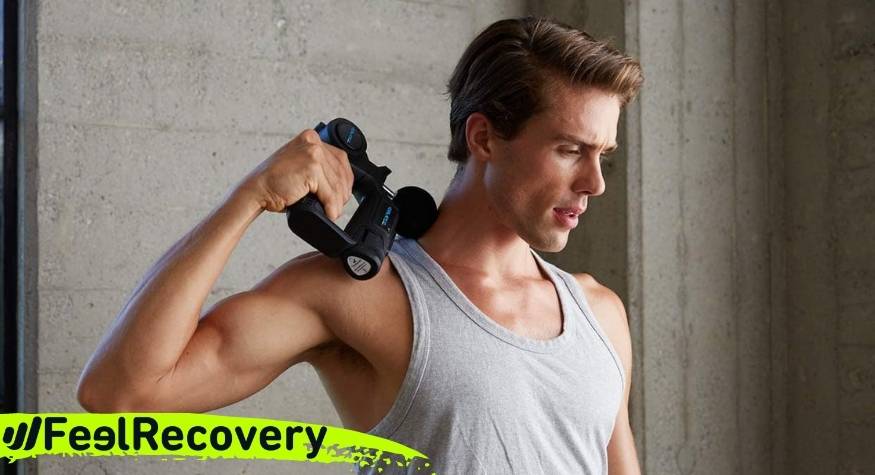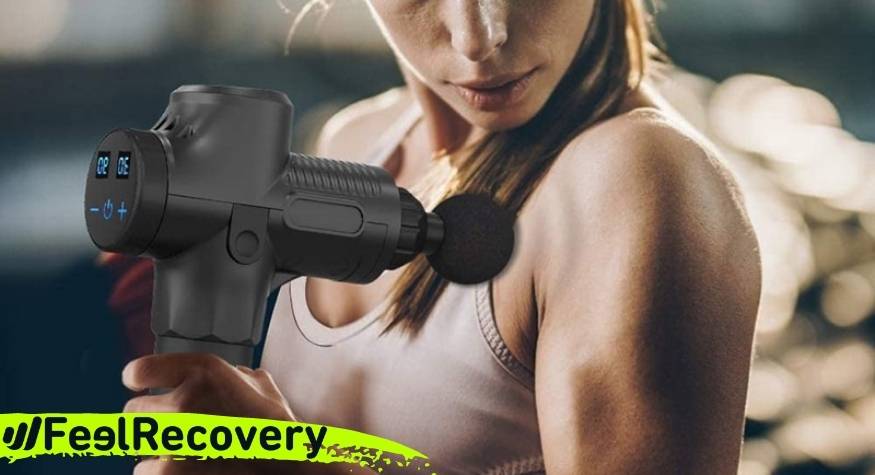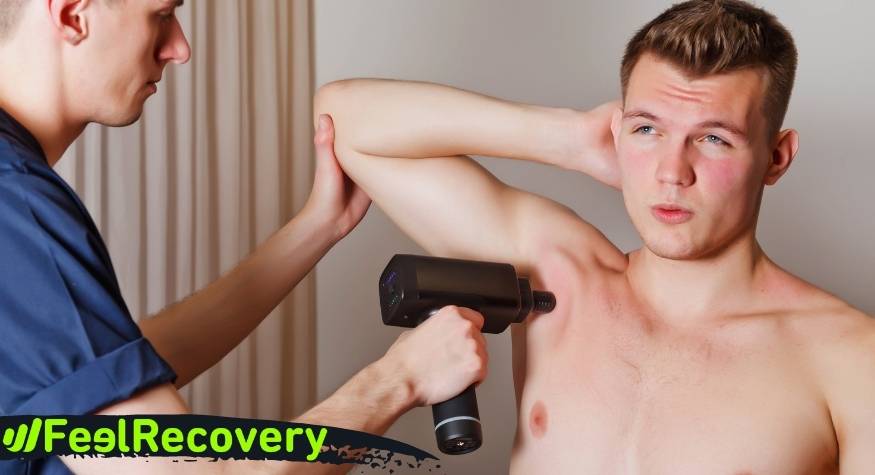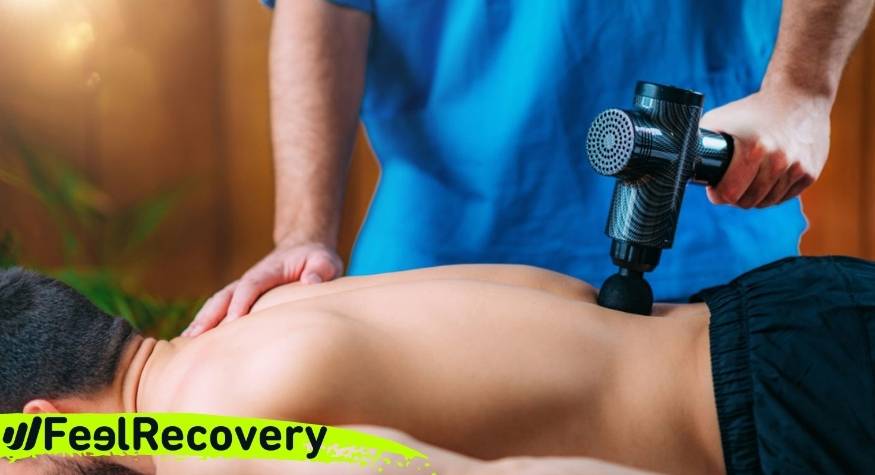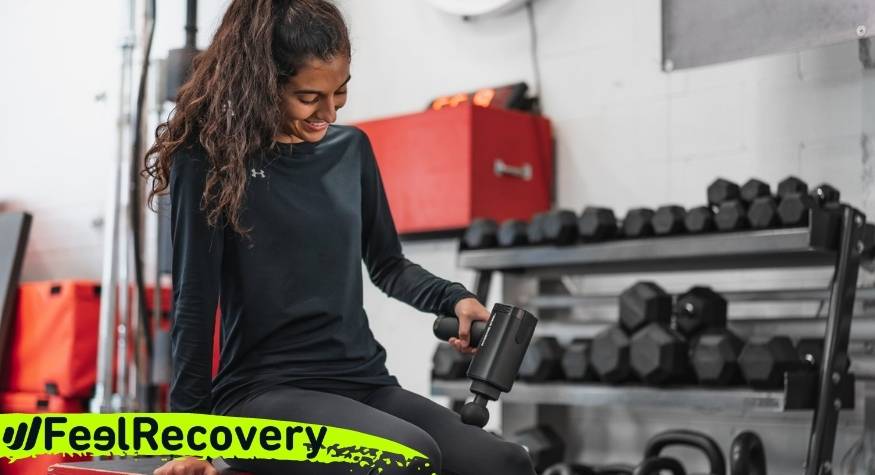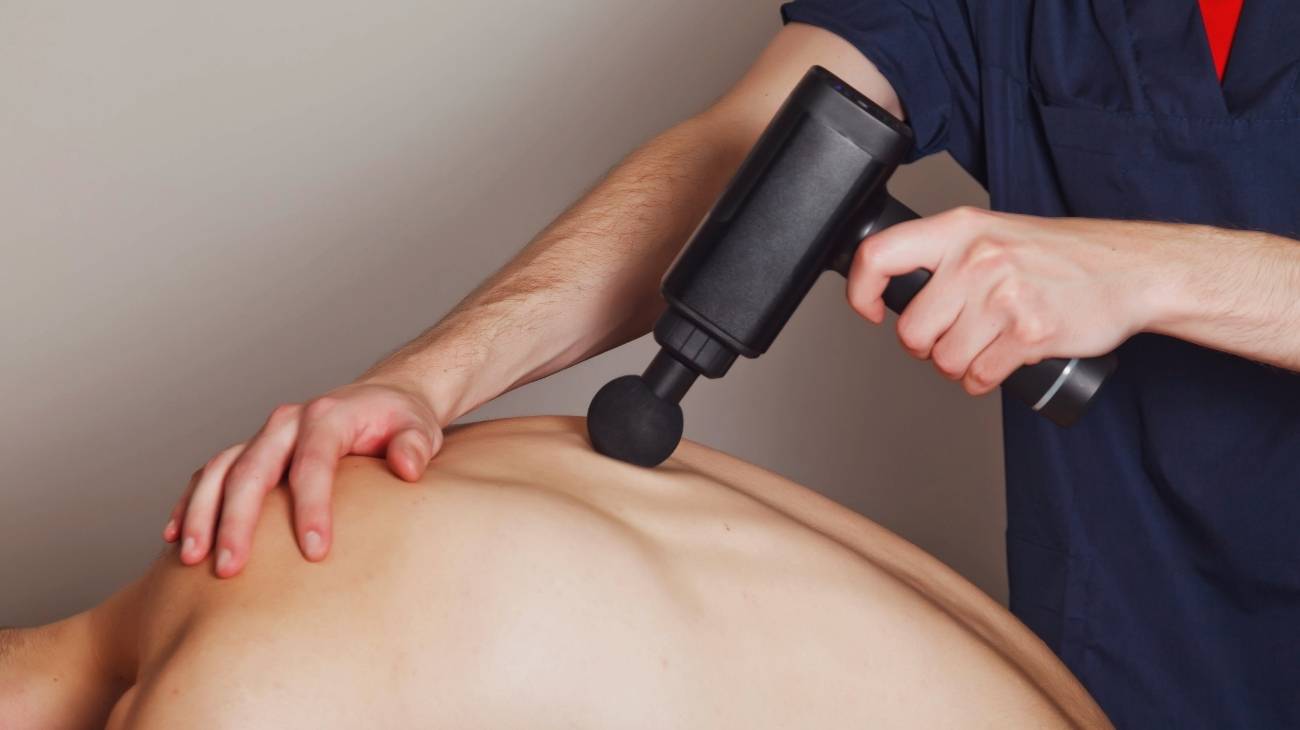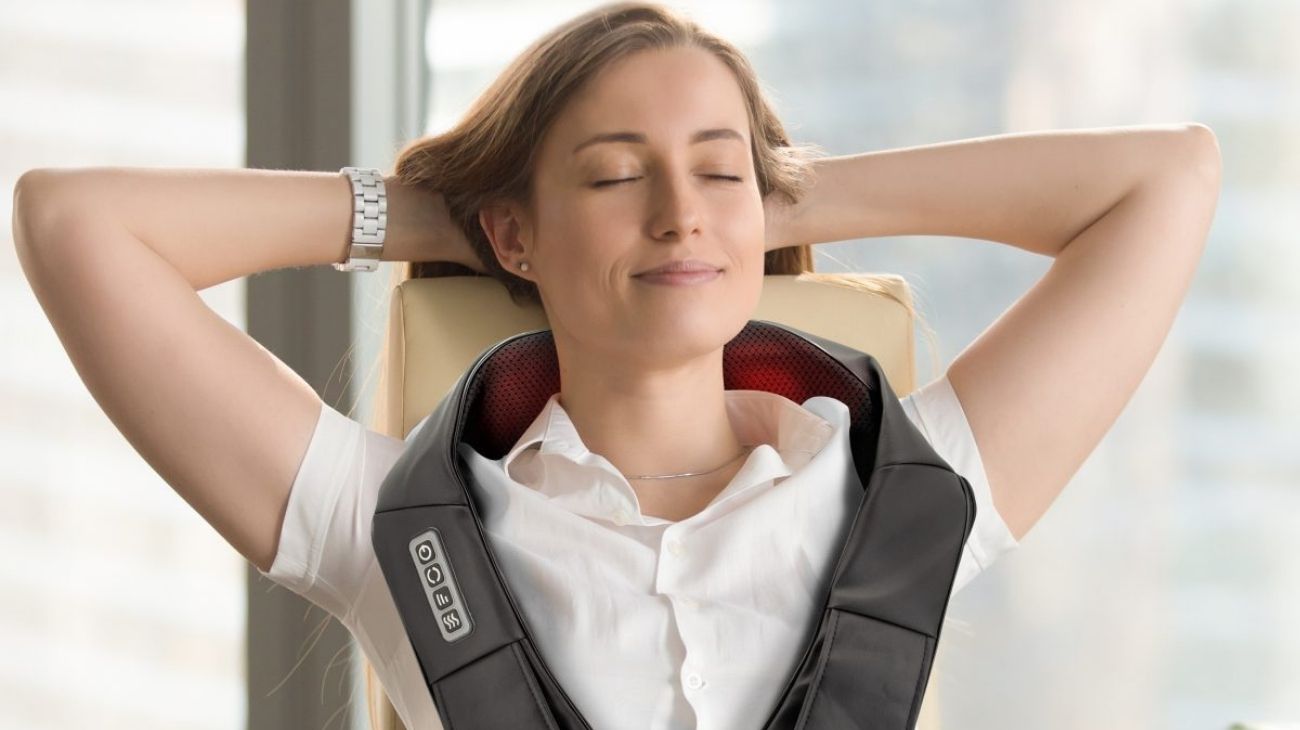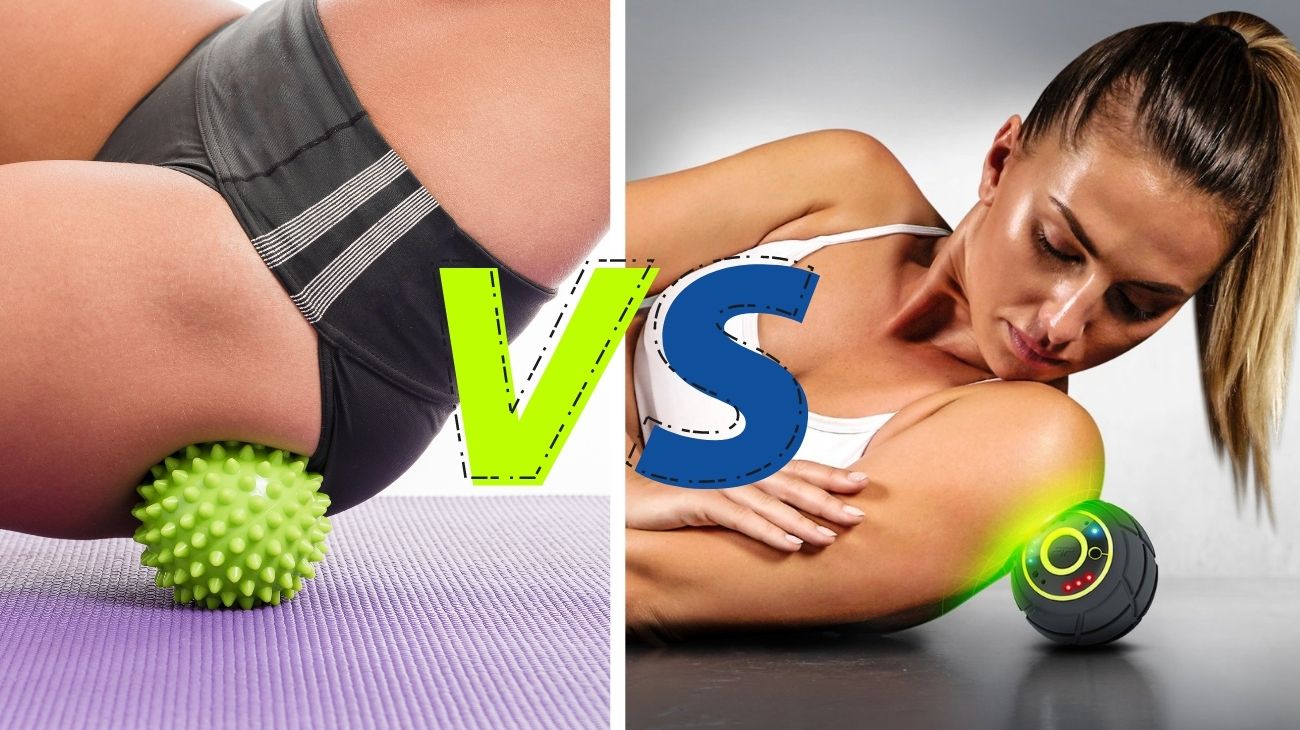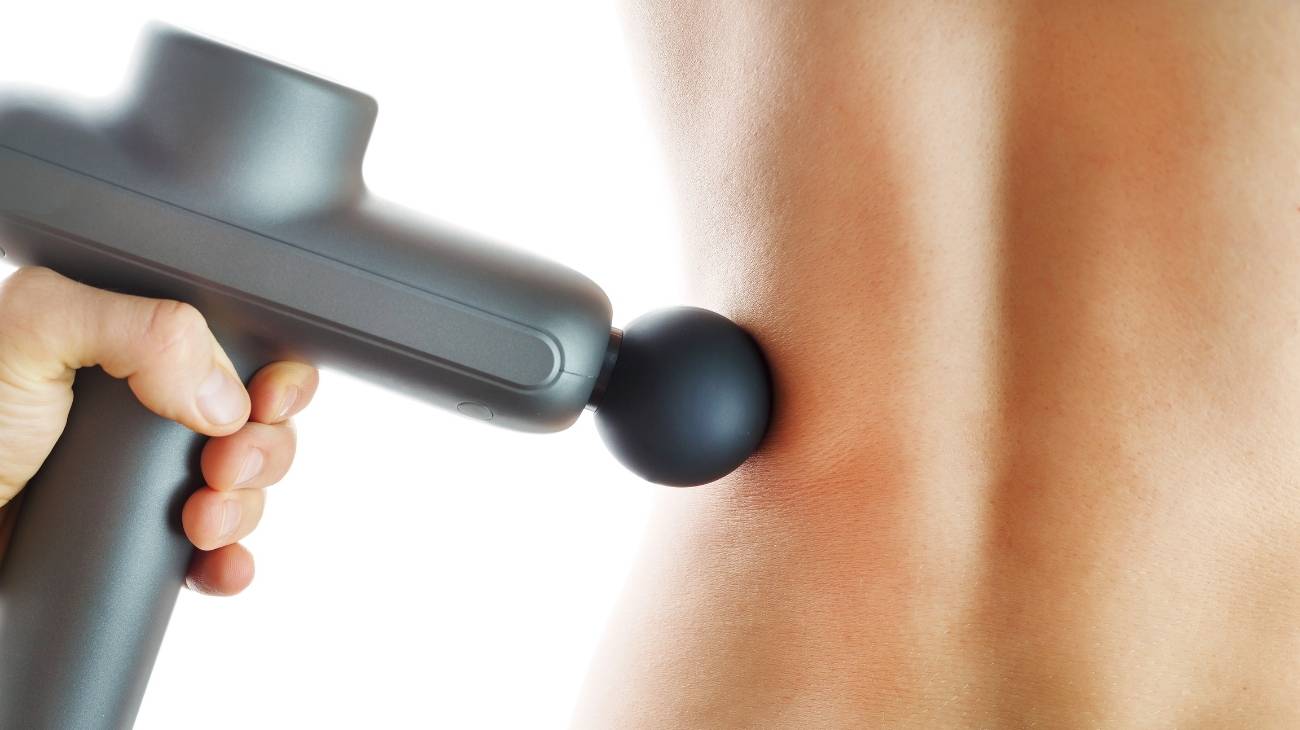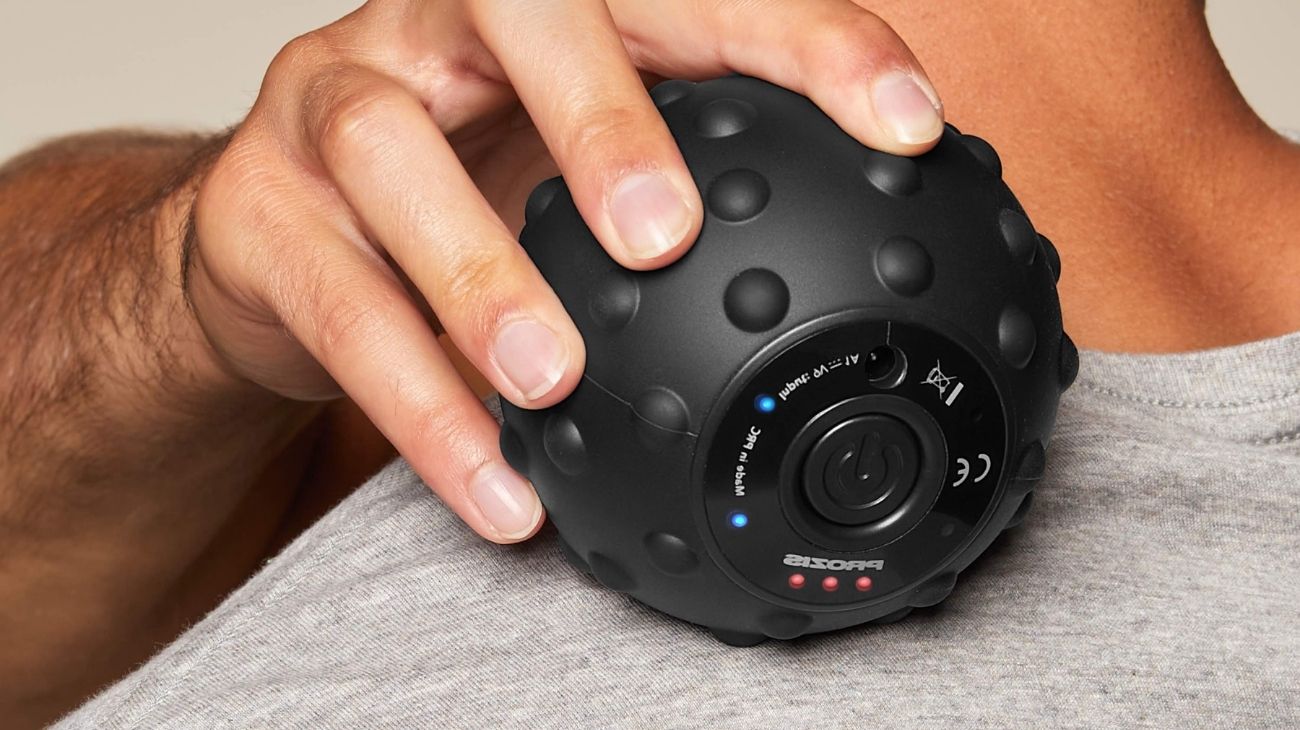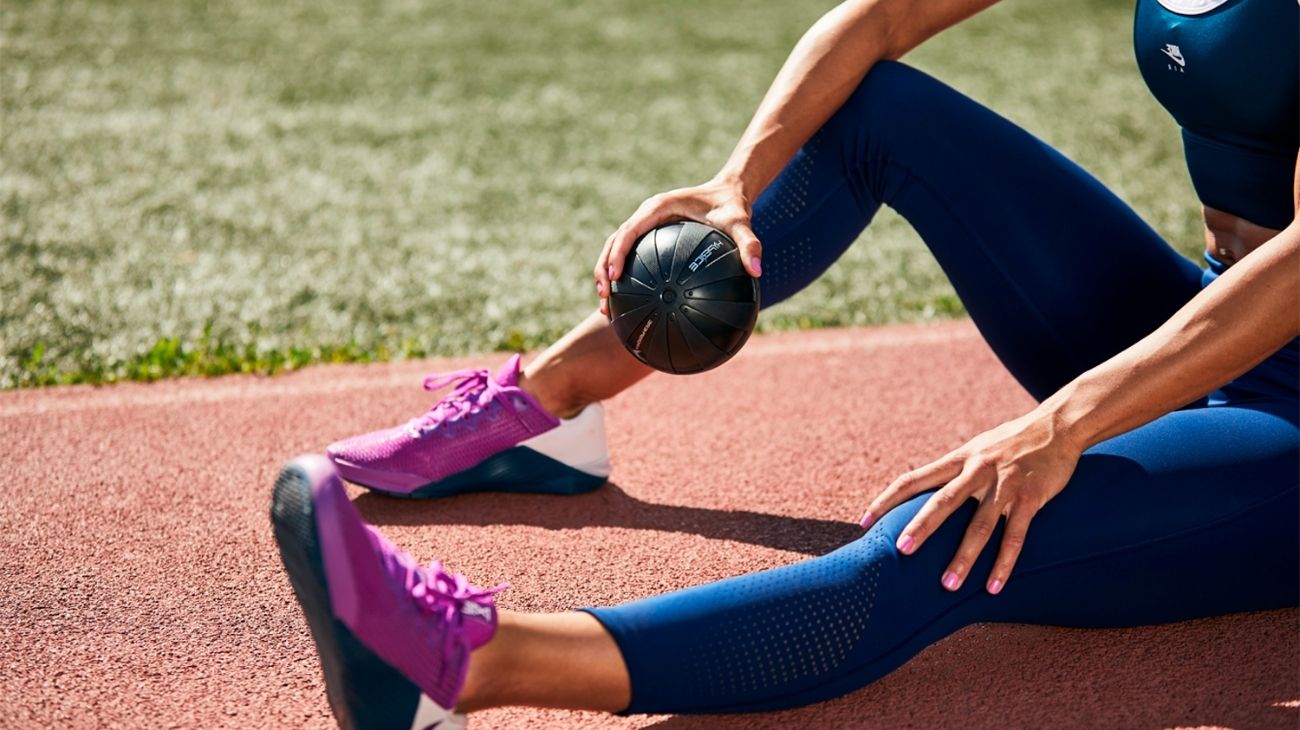Massage guns deliver hundreds of tiny, vertical strokes, but they reach deep tissues that can hardly be stimulated as well by other similar products, which is why they have gained popularity in the world of sports and physiotherapy.
To be clear, its main function is to soothe the pain generated by some minor injuries, but these are injuries that are in the muscles closer to the bones, where the human hand cannot offer the same benefits.
What are the benefits of using the massage gun to relieve ailments in a natural way?
Percussion massagers are non-invasive, fast-acting and easy to use when treating areas where the patient can use both hands. But in areas such as the back, it is better to have a third person.
These are the main benefits you achieve with the percussion gun:
- Eliminate trigger points: professionals classify these points as muscle nodules when the pain is at the site of the bulge, and as trigger points when the pain is in a connected area. The gun untangles these points by relaxing them and allowing better blood flow to them.
- It relaxes the musculature: there is no need for nodules in tissues that are tense and stiff. From the first application of the percussion gun, one feels relief from the tensions left by stress, unusual physical activities and sports training.
- Stress relief: People who often have a stressful and anxious life also suffer from minor muscle contractions that affect their quality of life. The neck and shoulders are the main parts of the body where the greatest pain is felt due to alterations in the control of emotions.
- Calms muscular pain: as long as the pain is physical and mild, the percussion gun can inhibit the sensory receptors in the skin so that this information does not reach the brain and spinal cord, which are responsible for translating through pain that there is a muscular injury.
- Increases circulation: this effect is achieved in a way where the gun has contact, what is wanted is that there is a better regeneration of healthy cells so that the body regains the mobility of before the injury occurred both in the muscle fibres and in the fascia.
- Supports the lymphatic system: the lymphatic system is similar to the circulatory system, but in the former there is no oxygen supply to the muscles. However, it is just as important and attention should be paid to fluid retention. The percussion gun also creates bridges so that the lymph circulates better and swelling in the legs is prevented.
- Helps eliminate lactic acid: although important for anaerobic metabolism, levels of this compound should not be too high because it prevents the entry of oxygen and nutrients that are favourable for muscle recovery. Pistols are used to accelerate this waste during the first hour after major physical activity.
- Protects joint function: when muscles are healthy, this promotes the fusion of ligaments and tendons, thus preventing injury and protecting joints. However, it is important to clarify that the gun should not be applied directly to any joint.
- Accelerates recovery: sportsmen and physiotherapists prefer to use the massage gun to stimulate tense and fatigued tissues, thus shortening the muscle recovery time, which varies according to the degree of injury. It is an effective way to ensure a quick return to the usual activities you enjoy most.
- It can be used as a complement for athletes: it is the use of the massage gun to warm up and cool down the body as part of a sports routine. Both phases of training are important to keep muscles strong, flexible and elastic. The time of use of the gun should be adjusted to give a type and time of massage before or after training.
What injuries and pains can be relieved by using percussion therapy?
Percussion therapy is more effective with the use of the electric massage gun than with the hands of an expert, because it generates uniform and precise blows that reach the most superficial tissues of the body as well as the deepest ones.
Although its main purpose is to control neuromuscular functioning, it allows the treatment of the following symptoms and injuries:
- Contusions: With contusions, people should be careful because there is often bruising, which is internal bleeding and the gun will increase blood circulation. Guidance from a physiotherapist should be sought to treat a contusion injury correctly.
- Contractures: this is due to excessive tension of the muscle fibres that prevent the muscles from returning to their resting state, changes in sporting intensity and activities to which the body is not accustomed are the most frequent causes. The pistol prepares the muscles to be active and avoid contractures.
- Muscle pain: is generated by any injury to the muscle tissue, which is made up of small fibres and thousands of myofibrils that are activated when the body needs to do flexions and extensions. In each intense movement, the myofibrils break down and recover with the support of the massage gun, through uniform stimulations.
- Trigger points: these are tense parts of tissue, palpable to the touch, which generate pain during movement in areas connected to them. A lot of pressure, albeit brief, and high intensity strokes are required to deactivate the trigger point, which may take one or several sessions depending on the area where it is located.
- Cellulite: when the origin of this pathology is due to fluid retention and accumulation of body fat, it is possible that the percussion gun has a favourable impact on the skin and fascia, where most of the risk factors that give way to the bumps and dimples left by cellulite are concentrated.
- Plantar fasciitis: this is one of the problems where the percussion gun works best, because it has soft, rounded heads to avoid damaging the membrane under the foot and to relax it sufficiently to eliminate stiffness and pain in that area. No more than 40 seconds at a time is required for relaxation.
- Cramps: These form after the end of physical activity and are involuntary movements of the muscle that is exhausted by the work done. Daily use of the pistol will help to prevent cramps and allow the tissues to heal quickly so that people can continue to be active.
- Migraines: chronic headaches are controlled by massaging the neck and shoulders, the parts of the body that are connected to the base of the skull and cause the headache. Before using the gun, it should be ensured that the source of the pain is a muscle injury in the neck.
- Sciatica: although the pistol can do little to treat the source of sciatica, the intense pain that occurs during this painful process can be treated by the pistol. Massage of the lower back, buttocks and thighs will make the pain more bearable. It is a tool to support the drugs.
- Cervicalgia: this is an annoying injury that will affect the way you move your head, muscle tension compressions also cause displacement of the vertebral discs, so you must be very careful with the use of the percussion gun in the neck to avoid greater evils.
When is it not advisable to use a massage gun?
Some of the cases in which the use of percussion massage therapy is not indicated include:
- Fractures: This is a serious injury that is outside the range of injuries allowed to be treated with the gun. The constant blows of this product will cause further complications to internal tissues and bones that will have increased sensitivity. What is sought is better blood supply, which is not possible with this product.
- Sprains: although with slight sprains it is possible to use the massager, this is not the case when a ligament is broken near the joints. Remember that bones should not be massaged, so in these cases it is better to use forms of care such as the PRICE therapy.
- Tendonitis, bursitis and other inflammatory injuries: rather than inflammatory injuries, these tend to be injuries close to or located in the affected joint itself, so it is also not advisable to give constant blows to these areas when there are injuries of this type.
- Torn ligaments and tendons: this is part of the conditions of a sprain, in which the rupture of ligament and tendon fibres must be treated in a different way to massaging with percussion pistols. These tissues would be agitated and damaged with immediate massage.
- Hypertension: this condition is treated with some types of manual massage, but not with the percussion gun because it does not have the desired effect of controlling blood pressure in general, helping the heart to pump blood.
- Deep vein thrombosis: the veins are too vulnerable to be massaged, and even with light vibrations it is not possible to avoid complications with thrombosis of this type, which affects the dilatation of the veins.
- Varicose veins: although it can cause swelling in the legs, the veins that tend to be deformed by this condition are the superficial veins, where the gun has a greater effect. Rather than helping circulation, it obstructs it, which is why its use is not recommended by specialists.
- Osteoporosis: As the bone structure loses its mass and becomes weak, the use of the gun as a method of strengthening the body is also not permitted, as the origin of the pain is not due to damage to the soft tissues. Only when supervised by a physiotherapist can people in some cases resort to massage.
- Muscular dystrophy: when the weakness and loss of muscle mass is due to a genetic problem, the percussion gun complicates the pathological picture because it further weakens the muscle fibres. Massage prevents further production of proteins that feed the muscles.
- Fibromyalgia: this disease causes increased sensitivity, pain and generalised muscle weakness; these symptoms should not be treated with massage via percussion. When people are unaware of the reasons, they tend to cause more damage when trying to massage themselves.
- Multiple sclerosis, lupus or scleroderma: the signs may pass as mild when the disease starts, but in reality there is severe damage to the protective layer of nerves, not something that should be treated with the percussion gun. Numbness, pain and tingling are some of the symptoms often mistaken for muscle damage.
- Arthritis: To alleviate the symptoms of arthritis, friction massage is more advisable than percussion massage, so it is important to have proper guidance from a specialist when treating arthritis pain. Arthritis is a degenerative disease, and timely massage is required in these cases.
How to use the massage gun to relax and release tension in your whole body?
When using this percussion gun you should alternate between various power levels ranging from 1200 revolutions per minute (RPM) up to 3200 RPM. To start with, it is best to use a soft round head. Check how to use this product according to your body area.
Neck
Whenever you stimulate the neck, you should do it with two types of heads for a safe massage
- Turn on the gun without touching the skin, while the device regulates its speed.
- Use the soft, round head to stimulate the sides of the neck.
- Use the gun diagonally, not perpendicular to the skin.
- Use smooth strokes, without touching bones.
- Place the gun in tight places and move the head back and forth.
- Remember to stimulate both sides for brief seconds.
- Position the head in a U-shape.
- If you can, ask someone else to use the gun for you.
- Stimulate the nape of the neck in a straight line from bottom to top.
- Make only one stroke.
- The "U" shape will prevent you from touching the vertebrae.
The stimulation at each point should not last more than 10 seconds. The whole session should not last more than one or two minutes if you use little pressure.
Arms and shoulders
To give a good massage, you should vary the head at least three times and be patient in carrying out the massage:
- Start with the smaller round head, because the muscles are less dense.
- Concentrate on one side of the body at a time.
- Make smooth, straight line strokes.
- Stimulate the arm and forearm first on the first stroke.
- Stop the gliding where you notice muscle nodules.
- Stay on tense areas for 20 minutes, then look for other tense points.
- Switch to the flat head, stimulate the shoulder musculature.
- You should massage the deltoids and part of the biceps brachii.
- When you move on to the trapezius, you should use the U-shaped head.
- Be gentle, use low pressure and revolutions per minute.
- Perform the same massage routine on the other side of the body.
The whole session should last between three and four minutes, the stimulation on each muscle group should not be longer than 30 to 40 seconds.
Trapezius and serratus muscle
When the collarbone area requires more attention, it is best if you concentrate only on that area:
- Stretch your arm out fully so that there is a better working area.
- Use only the U-shaped head.
- Start from the deltoids, always with low revolutions.
- When you reach the collarbone, avoid touching the bones, that's what the fork shape is for.
- When you feel tighter areas, you should not change the head to the bullet shape.
- Often, you don't need to slide, just place the gun on each muscle group.
The use of the gun should be as little as one minute, touching each muscle group for brief seconds to avoid bruising and further pain when moving the joint.
- For the serratus muscle, you need the softest head because the tissues are so close to the ribs.
- Without applying pressure, follow the silhouette of the ribs.
- You should not stop at any point over the muscles.
- You should only make one or two strokes on each side.
Stimulations should be gentle, lasting only a few seconds to avoid injury to the bone structure and muscle flexibility.
Back and lower back
This area concentrates most of the effort that people must make in order to receive correct stimulation:
- If you want a relaxing massage, start with the flat head.
- Follow the shape of the muscles as you move the gun.
- Focus for several seconds on the areas where there is the most stiffness.
- Do not exert too much pressure with your hands to avoid bruising.
- The movements should be gentle from the bottom upwards.
- To stimulate the latissimus dorsi, use the fork-shaped head.
- Make one or two gentle strokes from the base of the spine to the upper back.
- Avoid stopping at only one part of the spine.
- When you feel a lot of tension in the back area, you can use the bullet head.
- Massage those tense areas for 30 seconds.
On average, back massages can last between five and six minutes. You should massage each back muscle group for one minute as long as you keep moving, unless you put more effort into trigger points.
Legs and lower body
Leg massages are easier to do, because you have the full mobility of your hands to stimulate each part of the lower body.
- You should start from the thigh to the feet.
- Use the flat head to make one or two quick strokes on both legs.
- Switch to the round head and try to target the tightest areas of the thigh.
- Stay on the trigger points for 30 seconds if you don't feel pain.
- To stimulate these points, don't use pressure, just let the gun do its job.
- Once you have finished with the thigh, stimulate the calf with the round head.
- The calf and soleus are sensitive muscles, so don't use too much force.
- Move the pistol in a straight line at all times.
- Let the pistol travel from the calf to the start of the heel.
- If you feel you need more trigger point stimulation, use the bullet head.
- Just massage with this head for 30 seconds.
You should stimulate each muscle group for one or two minutes if your sensitivity allows it and if you notice relief from muscle pain. Use caution when using the pointed head to avoid bruising and soft tissue damage.
For massaging the plantar fascia in case of injury, it is advisable to use only a small round head.
- Apply the gun with the minimum number of revolutions per minute.
- Slide the gun in a straight line from the heel to the metatarsals.
- Make two or three passes with the gun if you feel relief.
- Then you should allow a rest of one hour before using again.
- Massaging only two or three times a day is recommended.
- Use the gun to stimulate the Achilles tendon and calf muscles.
- Priority should be given to the sole of the foot before massaging the calf.
Remember that when you want to massage the foot for plantar fasciitis, you must also treat the source of the injury, which is sometimes a malfunction of other muscle groups in the leg.

